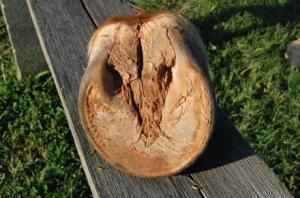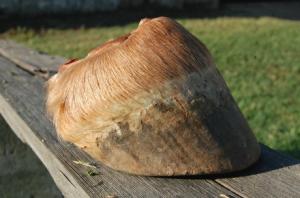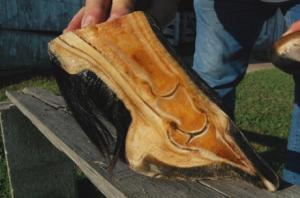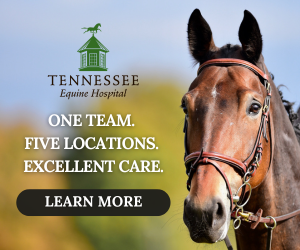by Mike Stine, Equine Dynamics © 2008
Over the past several years, there has been a lot of discussion of the benefits of natural hoof care versus traditional hoof care. Here are some observations I’ve made as a full time professional farrier and owner of both mustangs and domestic bred horses.
A horse’s lifestyle, environment, and genetic predisposition for hoof quality (good or bad) are often overlooked in discussions concerning trimming or shoeing needs. Lifestyle issues, which interfere with a horse’s natural movement patterns, can cause compression and imbalance in the hoof. This type of mechanical interference is most often caused by the unnatural demands of events and competition. Poorly fitted tack and improper weight distribution of the rider often cause the horse to carry load unevenly. This can cause spinal and body misalignment which further exacerbates the problems.
To counter these problems, people often ask their farrier to trim their domestic horses’ feet so that they look like mustang feet. The problem with this is that our domestic horses don’t live the life of a wild mustang, nor is natural selection a dominant force in their breeding. The environment and lifestyle of many domestic horses create hoof care challenges. In addition, conformation problems that are the result of centuries of breeding to create the ‘aesthetic’ horse also add to the problem. Horses have been bred for what we believe to be attractive characteristics, rather than those which would be good qualities for a horse. The results of this breeding have often led to small hooves in relation to the whole body, thin hoof walls, less bone mass, and smaller joints for body size. In contrast, a wild horse with unsoundness and poor hoof quality could not keep up with the herd and would not reproduce.
Stalls and turnout areas can also be a source of problems. All too often, stalls are improperly cleaned and fresh shavings are spread over urine soaked bedding, or horses are turned out in small paddocks and stand in their own feces day after day. For a horse that already has hoof quality issues, these conditions can lead to myriad of problems such as fungal infections, white line disease, thrush and shelly hoof walls. In contrast, wild horses don’t stand in feces or urine because they are constantly on the move. This level of exercise increases their metabolism and the blood flow through the foot, which improves hoof horn quality and growth.
Simply changing the horse’s environment from wild to domestic alters their hooves. When mustangs are first brought off the range, their hooves are much harder and the soles are thicker and callused. Over time in a domestic environment, they lose sole depth and their hooves get softer, even if the horse is on 24-7 turnout. The terrain is softer and less abrasive, which changes the loading and wear patterns of the hooves. Daily movement is also reduced, so there is less stimulation to the tissues, resulting in reduced hoof growth and circulation.
I was fortunate to observe this first hand when Dr. Ric Redden of Versailles, KY offered me a couple of wild mustangs for personal study a few years ago. I was excited to have a chance to confirm for myself much of the information from the wild horse studies. In particular, the research by Gene Ovnicek had intrigued me for some time. Ovnicek spent approximately 7 years in the field studying and documenting loading and wear patterns of the wild horse’s hooves.
The results of his study, plus 40 years of farrier experience, produced the Natural Balance guidelines for trimming and shoeing. His goal was to take what he learned from the wild horses to improve the lives of domestic horses.
Watching my own mustang (Sally) make the transition from a free range lifestyle in the western U.S. to a domestic one in the southern Piedmont area of North Carolina was a unique experience. No matter how much you respect someone else’s opinion, there is nothing like seeing it for yourself. I was amazed at the changes in this horse’s hooves, even though it was expected. The following are the main reasons for the changes I observed.
·In a domestic environment our horses are fairly sedentary, because pasture, hay and concentrated feed don’t require a lot of movement. In the wild, horses are constantly moving in search of food.
·Domestic horses get periodic trims rather than constant abrasion of the hooves.
·Pastures and paddocks limit movement, especially running.
·Riders and tack affect a horse’s feet by drastically altering movement, thus the loading and wear patterns of the hoof.
An extreme example of how a horse’s hooves adjust when exposed to unhealthy conditions comes from the area of North Carolina where I live. In the late 1980s, two young mares and a two-year-old stallion were turned out on 500 acres and pretty much left to fend for themselves. The horses, being adaptable creatures, survived and multiplied. They were eventually dubbed the “lost herd” by locals. From time to time, other domestic horses were added and some were taken out, but most of these horses have never had their feet trimmed. As of the last count, there were 32 horses split into a mare band and a bachelor band (colts). Their hooves would break off along weather lines fairly evenly. The bars were overgrown and occasionally abscesses would occur behind the bars, causing them to break out. The southern Piedmont area is not a very abrasive environment, compared to the western U.S., and is much wetter. The horses actually walked on a clay ball packed into their feet during the wet season.
‘The Lost Herd,’ mustang Sally, and other examples show that you must examine the whole horse plus his environment and lifestyle before deciding on the trimming or shoeing approach that would be most beneficial. Each horse is an individual and its needs change over time. However, most horses will benefit from a more natural trim. If the horse is shod, the shoeing should be an extension of that. My goal is to educate horse owners about the major items that can affect the hooves: the environment (hard rocky ground vs. soft wet clay, etc); their exercise regimen; the horse’s lifestyle (standing/walking vs. walking/running); saddle fit and rider posture; and whole body issues such as muscle development (even/uneven on both sides) and conformation. Understanding these factors gives you a good foundation to develop an individual approach for your horse. I firmly believe that knowledge and awareness are the first steps toward positive change to make life better for your horse.
Mike Stine is a Registered Journeyman Farrier (RJF) and Certified Natural Balance Farrier & Trimmer (CNBF, CNBT) who specializes in equine biomechanics and whole horse evaluation. In 2010, he was Official Farrier for the FEI qualifier at The Fork Horse Trials in NC and in 2008 served as evaluating farrier for the USEF Endurance Team East Coast training session. Under the name Equine Dynamics, Mike provides farrier services and conducts educational programs in the U.S. and abroad. For more information visit www.equinedynamics.comor email mike@equinedynamics.com
Over the past several years, there has been a lot of discussion of the benefits of natural hoof care versus traditional hoof care. Here are some observations I’ve made as a full time professional farrier and owner of both mustangs and domestic bred horses.
A horse’s lifestyle, environment, and genetic predisposition for hoof quality (good or bad) are often overlooked in discussions concerning trimming or shoeing needs. Lifestyle issues, which interfere with a horse’s natural movement patterns, can cause compression and imbalance in the hoof. This type of mechanical interference is most often caused by the unnatural demands of events and competition. Poorly fitted tack and improper weight distribution of the rider often cause the horse to carry load unevenly. This can cause spinal and body misalignment which further exacerbates the problems.
To counter these problems, people often ask their farrier to trim their domestic horses’ feet so that they look like mustang feet. The problem with this is that our domestic horses don’t live the life of a wild mustang, nor is natural selection a dominant force in their breeding. The environment and lifestyle of many domestic horses create hoof care challenges. In addition, conformation problems that are the result of centuries of breeding to create the ‘aesthetic’ horse also add to the problem. Horses have been bred for what we believe to be attractive characteristics, rather than those which would be good qualities for a horse. The results of this breeding have often led to small hooves in relation to the whole body, thin hoof walls, less bone mass, and smaller joints for body size. In contrast, a wild horse with unsoundness and poor hoof quality could not keep up with the herd and would not reproduce.
Stalls and turnout areas can also be a source of problems. All too often, stalls are improperly cleaned and fresh shavings are spread over urine soaked bedding, or horses are turned out in small paddocks and stand in their own feces day after day. For a horse that already has hoof quality issues, these conditions can lead to myriad of problems such as fungal infections, white line disease, thrush and shelly hoof walls. In contrast, wild horses don’t stand in feces or urine because they are constantly on the move. This level of exercise increases their metabolism and the blood flow through the foot, which improves hoof horn quality and growth.
Simply changing the horse’s environment from wild to domestic alters their hooves. When mustangs are first brought off the range, their hooves are much harder and the soles are thicker and callused. Over time in a domestic environment, they lose sole depth and their hooves get softer, even if the horse is on 24-7 turnout. The terrain is softer and less abrasive, which changes the loading and wear patterns of the hooves. Daily movement is also reduced, so there is less stimulation to the tissues, resulting in reduced hoof growth and circulation.
I was fortunate to observe this first hand when Dr. Ric Redden of Versailles, KY offered me a couple of wild mustangs for personal study a few years ago. I was excited to have a chance to confirm for myself much of the information from the wild horse studies. In particular, the research by Gene Ovnicek had intrigued me for some time. Ovnicek spent approximately 7 years in the field studying and documenting loading and wear patterns of the wild horse’s hooves.
The results of his study, plus 40 years of farrier experience, produced the Natural Balance guidelines for trimming and shoeing. His goal was to take what he learned from the wild horses to improve the lives of domestic horses.
Watching my own mustang (Sally) make the transition from a free range lifestyle in the western U.S. to a domestic one in the southern Piedmont area of North Carolina was a unique experience. No matter how much you respect someone else’s opinion, there is nothing like seeing it for yourself. I was amazed at the changes in this horse’s hooves, even though it was expected. The following are the main reasons for the changes I observed.
·In a domestic environment our horses are fairly sedentary, because pasture, hay and concentrated feed don’t require a lot of movement. In the wild, horses are constantly moving in search of food.
·Domestic horses get periodic trims rather than constant abrasion of the hooves.
·Pastures and paddocks limit movement, especially running.
·Riders and tack affect a horse’s feet by drastically altering movement, thus the loading and wear patterns of the hoof.
An extreme example of how a horse’s hooves adjust when exposed to unhealthy conditions comes from the area of North Carolina where I live. In the late 1980s, two young mares and a two-year-old stallion were turned out on 500 acres and pretty much left to fend for themselves. The horses, being adaptable creatures, survived and multiplied. They were eventually dubbed the “lost herd” by locals. From time to time, other domestic horses were added and some were taken out, but most of these horses have never had their feet trimmed. As of the last count, there were 32 horses split into a mare band and a bachelor band (colts). Their hooves would break off along weather lines fairly evenly. The bars were overgrown and occasionally abscesses would occur behind the bars, causing them to break out. The southern Piedmont area is not a very abrasive environment, compared to the western U.S., and is much wetter. The horses actually walked on a clay ball packed into their feet during the wet season.
‘The Lost Herd,’ mustang Sally, and other examples show that you must examine the whole horse plus his environment and lifestyle before deciding on the trimming or shoeing approach that would be most beneficial. Each horse is an individual and its needs change over time. However, most horses will benefit from a more natural trim. If the horse is shod, the shoeing should be an extension of that. My goal is to educate horse owners about the major items that can affect the hooves: the environment (hard rocky ground vs. soft wet clay, etc); their exercise regimen; the horse’s lifestyle (standing/walking vs. walking/running); saddle fit and rider posture; and whole body issues such as muscle development (even/uneven on both sides) and conformation. Understanding these factors gives you a good foundation to develop an individual approach for your horse. I firmly believe that knowledge and awareness are the first steps toward positive change to make life better for your horse.
Mike Stine is a Registered Journeyman Farrier (RJF) and Certified Natural Balance Farrier & Trimmer (CNBF, CNBT) who specializes in equine biomechanics and whole horse evaluation. In 2010, he was Official Farrier for the FEI qualifier at The Fork Horse Trials in NC and in 2008 served as evaluating farrier for the USEF Endurance Team East Coast training session. Under the name Equine Dynamics, Mike provides farrier services and conducts educational programs in the U.S. and abroad. For more information visit www.equinedynamics.comor email mike@equinedynamics.com











